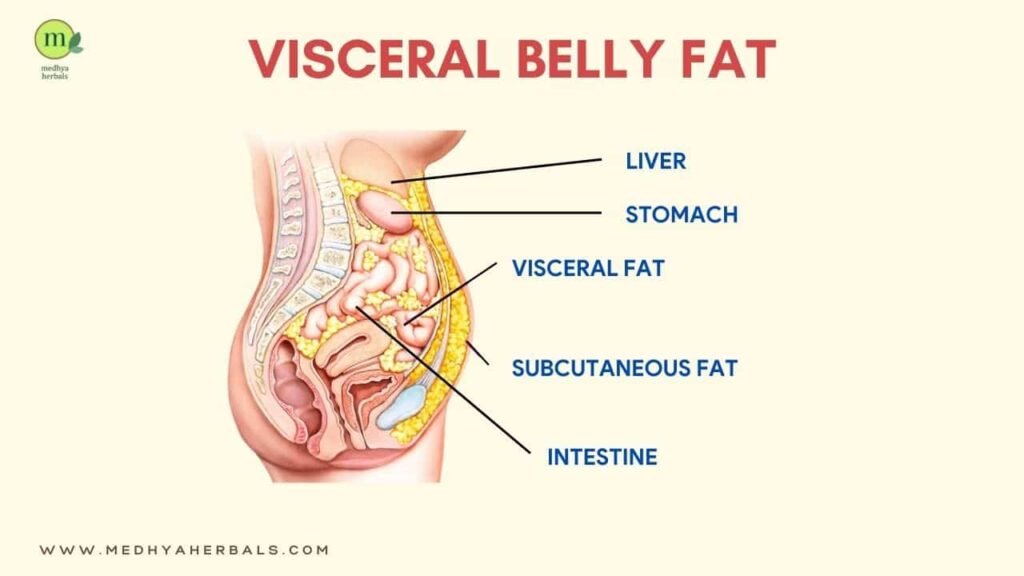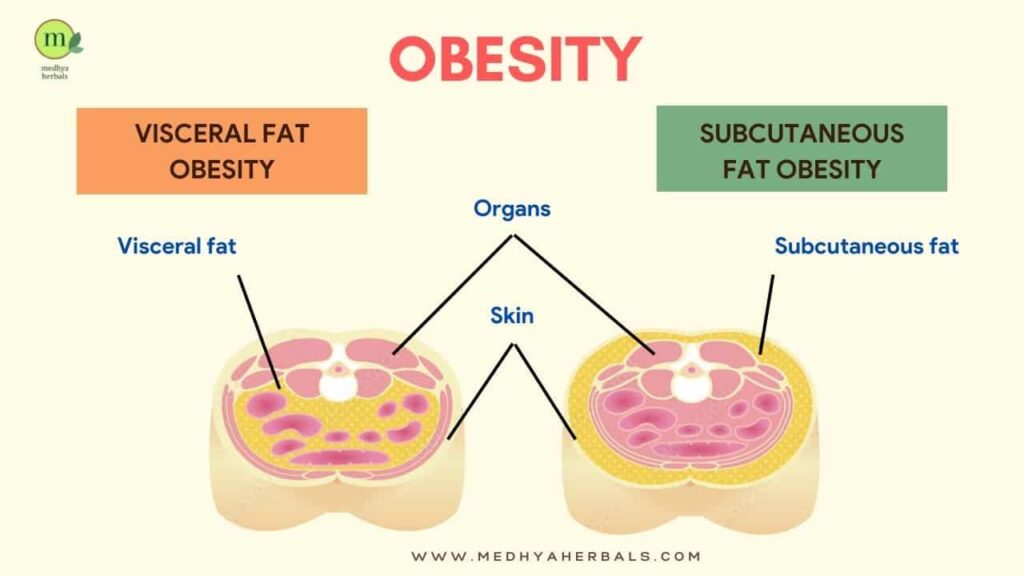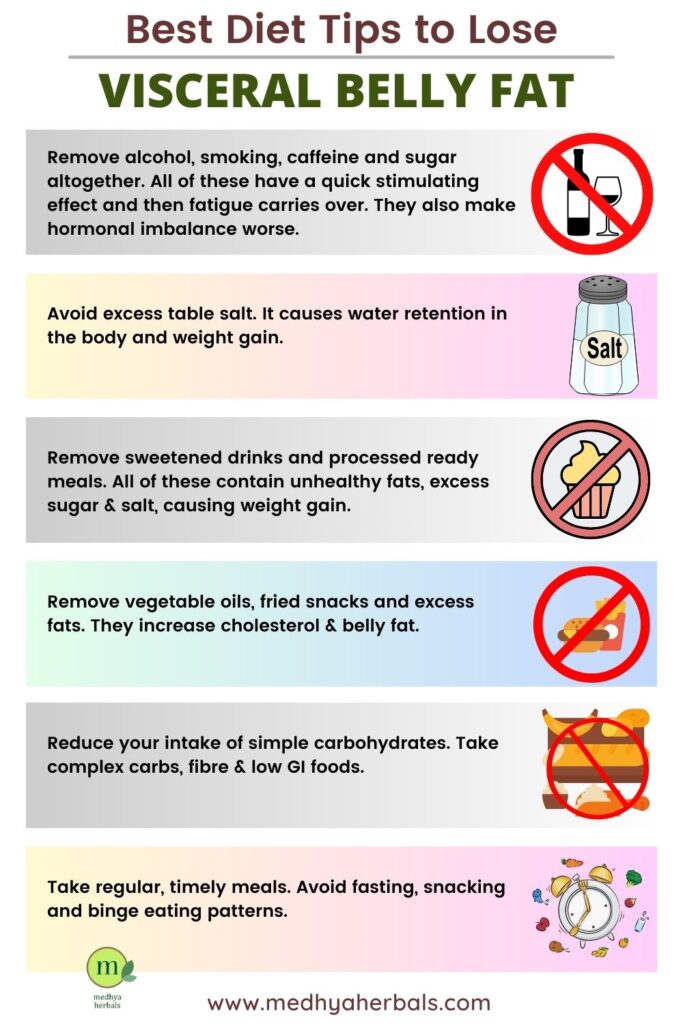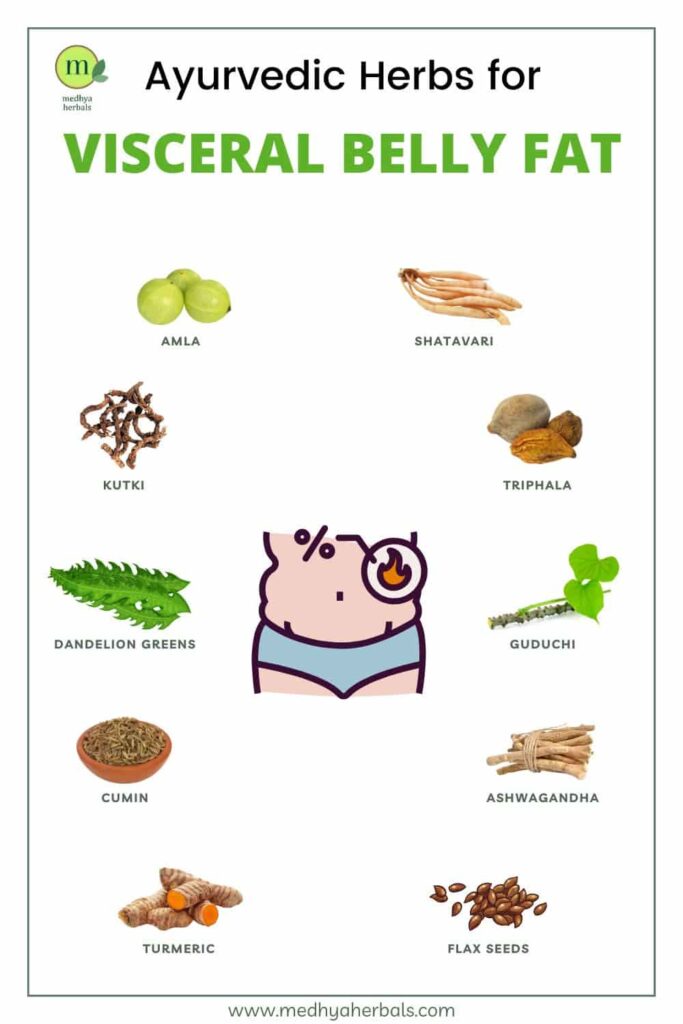Ever wondered why you can’t seem to shift that stubborn belly fat despite your best efforts at diet and exercise? The answer may lie deeper than you think: in visceral fat. I’m Dr. Bansal, an Ayurvedic Practitioner at Medhya Herbals, specializing in women’s health and wellness. My experience has shown me that many women are unknowingly dealing with high levels of visceral fat, a hidden health hazard that poses significant risks, such as type 2 diabetes and heart disease.
Visceral fat, often referred to as ‘deep fat’, wraps itself around your vital organs, which not only leads to an expanding waistline but can also result in serious health complications. A higher visceral fat level, as per the visceral fat level chart, can cause symptoms such as bloating, fatigue, and increased sugar cravings, which are often misdiagnosed or overlooked.
In this comprehensive guide, I promise to provide you with accurate, insightful, and practical information about visceral fat. Together, we’ll explore the science behind visceral fat, understand how it impacts your body, and most importantly, discover how to effectively reduce it using time-honored Ayurvedic treatments. The fight against visceral fat isn’t easy, but armed with knowledge and the right tools, you can win it. Let’s begin this journey to a healthier, happier you.
Understanding Visceral Fat
Before delving into strategies to reduce it, it’s essential to understand what visceral fat is, why it’s harmful, and how you can measure it using a visceral fat level chart.

What is Visceral Fat?
Visceral fat, often referred to as “deep fat”, is a type of body fat that’s stored within the abdominal cavity. Unlike subcutaneous fat that you can pinch on your arms, thighs, or belly, visceral fat is located further beneath the skin, surrounding vital organs like the liver, pancreas, and intestines.
This ‘hidden’ fat plays a critical role in hormone regulation and can also serve as an energy reserve. However, in excess, it becomes more than an aesthetic concern; it’s a serious health risk that can lead to chronic diseases like type 2 diabetes, heart disease, and certain types of cancer.

What is a Good Visceral Fat Level?
Maintaining a healthy visceral fat level is crucial for overall wellness. While some amount of visceral fat is necessary for hormonal balance and body functions, too much can lead to health issues.
The visceral fat level is usually measured on a scale from 1 to 59, with lower numbers indicating a healthier amount.
- Low Level (Rating 1-9): This is considered a healthy range, indicating that the individual has a moderate amount of visceral fat that doesn’t pose a significant health risk.
- Moderate Level (Rating 10-14): This indicates that the individual has a higher than average amount of visceral fat, and it’s a sign that they should consider lifestyle modifications to reduce it.
- High Level (Rating 15-20): At this level, the individual has an excessive amount of visceral fat which may pose serious health risks, such as heart disease and type 2 diabetes.
- Very High Level (Rating above 20): This level indicates a dangerously high amount of visceral fat. The individual is at a very high risk of developing health complications and should seek immediate medical attention.
Understanding the Visceral Fat Level Chart
A visceral fat level chart is a useful tool to gauge your visceral fat rating. It’s a visual representation that categorizes visceral fat levels into various ranges. It usually takes into account factors such as age and gender, as these can impact visceral fat accumulation.
The chart serves as a guideline to understand where you stand health-wise and to track your progress as you work towards reducing your visceral fat. By frequently checking your position on the chart, you can ensure that your lifestyle changes are effective in decreasing your visceral fat level.
In the end, it’s all about balance. A healthy lifestyle encompassing regular exercise, a balanced diet, and good sleep habits can help maintain an ideal visceral fat level, ultimately leading to a healthier, happier you.
How to Get Rid of Visceral Fat?
You can get rid of visceral belly fat with healthy lifestyle, regular exercise, herbs and most importantly by improving your diet. In fact, visceral fat responds very fast to the right changes in your diet and lifestyle.
So, as hard as it seems, it is actually quite easy to get back to being healthy by incorporating just small changes and sticking to them. The benefits of reducing visceral belly fat range from good fertility, hormonal balance, sustained weight loss, better sleep, heart, immunity and mental health.

Here are Ayurvedic natural ways to reduce visceral fat levels effectively:
1. Best Foods to Lose Visceral Belly Fat
A healthy diet plays a vital role in managing visceral fat. Include a variety of nutrient-dense foods in your daily meals.
- Consume plenty of complex carbohydrates. They will keep you full and provide B Vitamins and essential minerals.
- Cruciferous vegetables as cabbage, cauliflower and broccoli are great to include as they are rich in proteins and antioxidants.
- Increase your intake of fibre rich foods as greens, vegetables and whole grains. They act as a broom to clean the digestive tract, help to get rid of the toxins and keep you belly full for long time.
- Add herbs and spices to bring flavor and taste to your meals. Some examples are ginger, turmeric, cloves, cinnamon and black pepper.
- Consume bitter tasting foods. They help to burn fat and tone down your body. Examples are green leafy veggies, bitter gourd, herbs and spices.
- Choose lean protein sources. They contain fewer calories and the fiber in them will not let you feel hungry for longer. Thus you take fewer calories in the whole day.
- Include probiotic foods into your diet. They support healthy gut bacteria, improve your digestion and boost your metabolism.
2. Worst Foods for Visceral Belly Fat
Not all calories are the same! Calories from some foods make you store visceral belly fat, while other foods make you store muscle and burn fat. Here is a list of foods that you should avoid to get rid of hormonal belly:
- All processed foods and quick meals that are loaded with unhealthy fats, sugar and salt. They push in empty calories and devoid you of essential nutrients from your meals.
- When you consume too many calories dense foods as sugary drinks, foods or snacks then you will be prone to visceral belly fat.
- Avoid snacking in between meals.
- Remove sugar in the form of white sugar, artificial sugar and high fructose corn syrup.
- Reduce and remove caffeine. It leads to quick spike in your activity level, but eventually causes energy crashes. This makes you eat more sugary foods.
- Remove alcohol and smoking altogether. Both of these have similar stimulating effect as caffeine on the body, a quick energy boost and then crash. Also, alcohol and smoking cause and make hormone imbalance worse.
- We all know that starches and sugar raise insulin levels. But, after combining with fat both the insulin levels and fat storing hormones get increased.
- Avoid processed juices, carbonated beverages and flavored waters. All of these contain lots of sugar which cause weight gain.
- Remove deep fried foods and refined oils from your diet.
3. Increase Physical Activity to Get Rid of Belly Fat
Regular exercise helps burn calories and reduce fat levels throughout your body, including visceral fat. A combination of cardiovascular exercise, strength training, and high-intensity interval training (HIIT) can be particularly effective.
Cardiovascular exercise, such as brisk walking, running, or cycling, can help burn calories and improve heart health. Strength training helps build lean muscle mass, which can boost your metabolism and increase fat burning even while at rest. HIIT, which involves short bursts of high-intensity exercises followed by brief rest periods, is shown to be especially effective at reducing visceral fat.
4. Yoga Asana to Burn Visceral Belly Fat
Regular practice of right yoga asana helps to tone up abdominal muscles, balances hormones and stimulates fat loss from the belly.
Here are some yoga asana that are highly effective to lose visceral belly fat:
- Bhujangasana (Cobra pose): Strengthens abdominal muscles, Massages Liver and Boosts Metabolism
- Dhanurasana (Bow pose): Burns Belly Fat, Tones up liver and Stomach, Builds Abdominal Muscles
- Kumbhakasana (Plank Pose): Burn your tummy fat and tones up your muscles
- Naukasana (Boat pose): Works on your side and front tummy muscles and strengthens your core
- Ustrasana (Camel Pose): Strengthens back and abdominal mucles, tones up belly and liver, stimulates fat loss
- Eka Pada Adho Mukha Svanasana (One-Legged Downward-Facing Dog Pose): Strengthens the back, promotes cirulcation and detoxification, boost fat metabolism

5. Ayurvedic Herbs to Cut Visceral Fat
Ayurvedic herbs and formulations help to burn off stubborn belly fat. Hence, they curb many diseases associated with it. Here are some Ayurvedic herbs that can help you to lose weight and clear the toughest of the fats:
1. Triphala
Triphala is a powerful Ayurvedic Rasayana (Herbal elixir known to promote longevity and rejuvenation).
It deeply cleanses our body and helps to flush out wastes and toxins. Triphala has powerful antioxidants to rejuvenate, inhibit inflammation, promote healthy build of body cells, and blood purification.
2. Ashwagandha
Ashwagandha is a powerful adaptogen and a revered Ayurvedic elixir for rejuvenation and nourishment. It is a natural supplement to lower cortisol and balance thyroid hormones.
It reduces stress and increases our body’s strength. Regular consumption of Ashwagandha elevates the brain chemicals, helps to relax, and establishes hormone balance.
3. Guduchi
Guduchi or Giloy is one of the most powerful herbs for eliminating toxins from the blood and liver. Traditionally Guduchi is used for inflammation of the skin and cooling fevers.
It is detoxifying, antiparasitic, anti-viral, and anti-bacterial. Guduchi is indicated whenever a cooling and reducing therapy is needed.
4. Dandelion Greens
It helps in weight loss by limiting calorie intake through suppression of hunger. Dandelion also stimulates secretion of gastric enzymes and induces satiation.
It promotes the breakdown of fat and cholesterol in the body. Dandelion is also a diuretic, which helps the body get rid of excess water weight.
5. Vijaysar
The bark of Vijaysar tree is used in multiple Ayurvedic formulations for excess body weight (Kapha Imbalance) and Diabates.
Vijaysar helps to burn stubborn belly fat due to its fat reducing properties. Regular consumption of Vijaysar tea can help to maintain good metabolism, healthy digestive system and get rid of excess body fat.
6. Garcinia Combogia
This is a tropical fruit that blocks liver action of excess fat generation. Hydroxycitric acid (HCA) present in Garcinia Combogia helps to boost metabolism, reduces appetite and flush out excess toxins from the body.
It is also known as Malabar tamarind. Garcinia is also known to reduce stress, manage blood sugar level and reduce high cholesterol.
7. Guggul
Guggulu is a well known Ayurvedic remedy for weight loss due to its powerful stimulating and scraping properties. It is not really a herb, but it is made from the sap (gum resin) of the Commiphora Mukul tree.
Guggul helps to burn fat, lose weight successfully and also improves the fat profile by lowering down high cholesterol values.
However, guggul alone is usually very strong for the body. Hence, it is often blended with synergistic and complimentary Ayurvedic herbs to achieve health benefits.
8. Ginger
Ginger is one of the most useful kitchen herb that supports all the processes of digestion and detoxification. It is also anti-inflammatory in nature, boosts metabolism and reduces body fat.
Add ginger to your meals or sip it as herbal tea with other ingredients as lemon and honey.
You can also chew a thin slice of ginger with rock salt to stimulate digestive fire and build up your appetite before meals.

6. Sleep Well to Start Burning Fat Fast
Lack of sleep is linked to weight gain and increased visceral fat. Aim for seven to nine hours of quality sleep per night. Establish a regular sleep schedule and create a conducive sleep environment to enhance your sleep quality.
A good sleep can improve hormone secretion and blood hormone levels. As a result of restful sleep, our appetite and stress hormones get reorganized; metabolism increases, and we stop craving for food.
To get sufficient sleep, try different soothing essential oils before bed, reduce caffeine and sleep in a dark, peaceful place.
7. Manage Stress
Chronic stress build up high cortisol levels in the body. Cortisol suppresses metabolism as it prepares the body for the fight and flight response. It also pushes in excess glucose in the blood, raising blood sugar levels and promoting fat storage in the belly area.
Thus, high stress increase storage of visceral belly fat. It is same for all age groups, however women at Menopause or those struggling with hormonal imbalances are more sensitive to it.
Manage and lower stress by:
- Deep breathing exercises and yogic breathing
- Spending time in nature and with your loved ones
- Remove and reduce stress triggers
- Take time off and invest in self care measures
- Deep body massage
- Practice meditation
Conclusion
FAQ
What should my visceral fat percentage be for my age?
The ideal visceral fat percentage varies depending on factors like age, sex, and ethnicity. However, as a general guideline, a healthy visceral fat level for adults of any age is typically around 10% of the total body fat. This percentage might be slightly higher for women due to biological differences. It’s essential to note that these values can fluctuate based on individual health factors, so it’s advisable to consult with a healthcare professional or an Ayurvedic practitioner like myself to determine the ideal visceral fat level for your specific circumstances.
Can you be skinny and have high visceral fat?
Absolutely, you can be ‘skinny’ or within a healthy weight range and still have high visceral fat levels, a condition often referred to as “skinny fat” or metabolically obese normal weight (MONW). This situation arises when the body stores excess fat around the organs, even if subcutaneous fat levels (the fat you can pinch) are relatively low. It’s a silent risk as those individuals may appear lean, but due to the harmful location of their fat stores, they could still be at risk for conditions like heart disease, diabetes, and other metabolic complications. Therefore, focusing on overall body composition, rather than just body weight or body mass index (BMI), is crucial for evaluating health risks and planning effective lifestyle interventions.
Is visceral fat always belly fat?
Visceral fat and belly fat are terms that are often used interchangeably, but they’re not entirely the same. Belly fat is a general term that refers to all the fat in your abdominal region. This includes both subcutaneous fat (the fat just beneath your skin that you can pinch) and visceral fat (the deeper fat that surrounds your organs).
However, visceral fat is specifically the fat stored within the abdominal cavity, surrounding vital organs such as the liver, pancreas, and intestines. It’s more dangerous than subcutaneous fat because it can secrete harmful substances into your bloodstream and increase the risk of conditions such as heart disease, type 2 diabetes, and certain types of cancer. So while all visceral fat is technically belly fat, not all belly fat is visceral fat. The distinction is crucial to understand, as it influences the strategies you’ll need to employ to effectively and healthily reduce it.
How does visceral fat leave the body?
Visceral fat leaves the body through a process known as lipolysis. When the body requires energy, it turns to fat stores, including visceral fat, and breaks down the triglycerides contained within the fat cells into glycerol and free fatty acids. These compounds then enter the bloodstream and are delivered to the muscles where they’re used for energy. This metabolic process is regulated by various hormones, including insulin, glucagon, and certain growth hormones.
It’s important to note that this process doesn’t discriminate between visceral fat and subcutaneous fat. The body tends to draw from both stores for energy. However, studies suggest that with regular exercise, particularly high-intensity workouts, the body can be more inclined to use visceral fat stores for energy. Additionally, a balanced diet that maintains stable blood sugar levels can help regulate the hormones involved in lipolysis, further supporting the reduction of visceral fat levels. Remember, the process of losing fat is gradual, and it requires consistent lifestyle changes to make a lasting impact.
How to lose visceral fat in 2 weeks?
While it’s understandable to seek rapid results, it’s crucial to know that healthy and sustainable fat loss, particularly visceral fat, takes time. A two-week period is a relatively short timeframe to observe significant changes in visceral fat levels. However, by starting to incorporate healthier habits into your routine, you can begin to lay the foundation for long-term visceral fat reduction.
For starters, regular physical activity, particularly high-intensity interval training (HIIT) and strength training, can help trigger visceral fat loss. In addition, adopting a balanced diet rich in whole foods, lean proteins, healthy fats, and complex carbohydrates can support overall fat loss. Reducing the intake of processed foods, sugars, and unhealthy fats is equally important. Additionally, managing stress levels through practices like yoga or meditation and ensuring adequate sleep can also contribute to maintaining healthy visceral fat levels. Remember to consult with a healthcare professional or Ayurvedic practitioner before starting any new diet or exercise program. True health isn’t achieved overnight, but every step you take towards a healthier lifestyle brings you closer to your goal.
Does walking burn visceral fat?
Yes, walking can indeed help burn visceral fat. Walking is a low-impact, cardiovascular exercise that, when done consistently and at a moderate to brisk pace, can contribute to fat loss, including the reduction of visceral fat. When you walk, you burn calories, and over time, this caloric deficit can lead to overall body fat loss.
Since fat loss generally occurs across the whole body rather than in one specific area, this means that visceral fat can also be reduced. Furthermore, walking has the added benefits of improving heart health, boosting mood, and enhancing overall fitness levels. As with any exercise regimen, consistency is key, so try to make walking a regular part of your routine for optimal benefits.


This was such a great post!
Very informative and easy to comprehend…
Thank you for sharing and for all the tips on helpful foods and exercises!
It has helped me immensely!
I think I may have PCOS, I'd never heard of it I have sideways growing hairs in my chin it's very ugly -.im also very heavy 61 years old …tired of living
Hi Cheri, at 61 yrs PCOS is unlikely as Menopause would have arrived by now. However, excess weight and belly fat do lead to hormonal imbalances, which cause symptoms of unwanted facial hair, balding, skin patches, lethargy and lack of motivation. We provide Ayurvedic treatment for hormonal imbalances and excess weight. You can schedule consultation here: https://medhyaherbals.com/ayurvedic-treatment/
Nameste lam suman 60 years I tried everything to loose weight but very hard loose thanks
Hello! Please message at +6581286582, we will help you out with Ayurvedic treatment, diet and lifestyle.